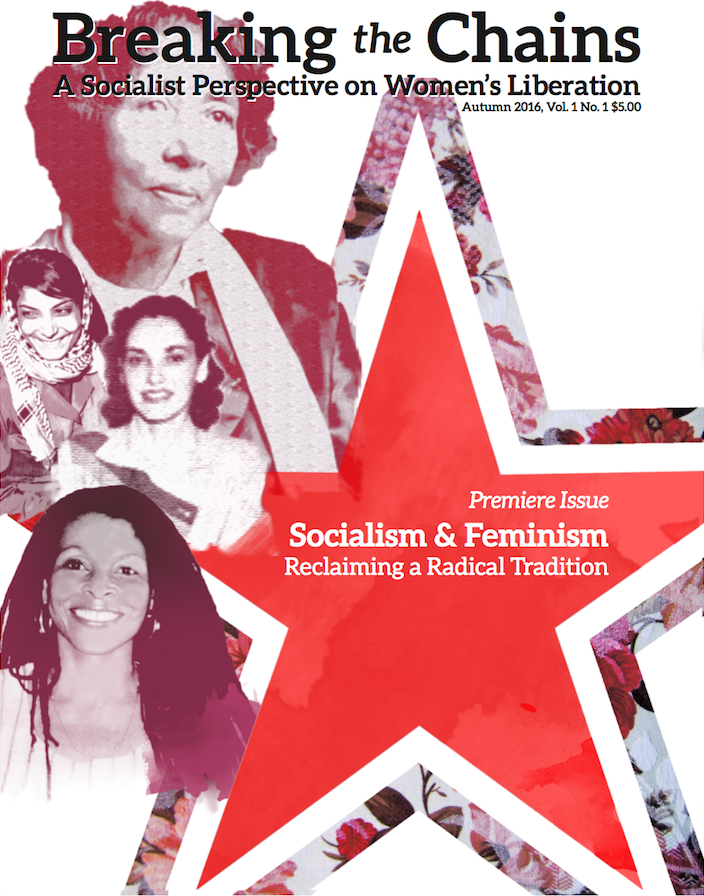A review of Breaking the Chains: A Socialist Perspective on Women’s Liberation; published quarterly by Liberation News.
Women around the country are today asking themselves: How can women best defend and expand their rights in the age of Trump? A new magazine, Breaking the Chains: A Socialist Perspective on Women’s Liberation, has given serious thought to these questions, and provides an exciting perspective on how women can fight back and win.
This premier issue may surprise some with its theme: “Socialism and Feminism, Reclaiming a Radical Tradition,” as many see socialism and feminism as opposing views. Not so these authors. According to editor Nathalie Hrizi, the writers here call themselves “revolutionary socialist and feminist.” They tap “the best in both political trends for the advancement of women of all classes, nationalities, and sex and gender orientations.” Author Radhika Miller adds, Breaking the Chains seeks to “embrace the militancy of the women’s movement and carry it forward.”
Among the questions explored here are: What lessons from the past struggles can help make a new women’s movement strong and effective? Who are women’s allies, and who are their enemies? What are the ways that the establishment divides women from each other and how can they be overcome? Is there a way to permanently secure women’s rights so they aren’t
constantly under attack? These themes are explored in analytical articles, short profiles of women who fought back, and in poetry and graphic art.
Not Hillary Clinton’s “feminism”
You will not find here the Hillary Clinton brand of “feminism.” Writer Julia Rapp calls the former Secretary of State’s version of feminism “a ruling class ideal.” Clinton “is for women’s rights insofar as it does not contradict the interests of the class she represents. She is for a feminism that is so narrowly defined that it exclude working class women and women of color as well as women living in any country targeted by US imperialism” such as Syria, Iraq and Libya, where women bear the brunt of the war and devastation that Clinton so eagerly backs.
In marked contrast, this magazine speaks to the needs of the “millions of women in this country who have no access to full health care and reproductive control over our bodies, who earn far less than men for the same work, whose education is imbued with sexism, who are victims of domestic and police violence, who are subjected to sexual assault while the perpetrators walk free” says Hrizi. “We are concerned with women of all ages and nationalities who are denied very basic and real human rights.”
These writers are feminists who teach in public schools and work in service jobs. They are feminists who know what it is like to the struggle to put food on the table. They are feminists whose families have been torn apart by deportation and mass incarceration. Their life experience tells them that change doesn’t trickle down, and neither does power. “While it is true that Trump is a poisonous racist and sexist bigot,” Rapp continues, “Hillary Clinton is not the antidote. The antidote is building a movement capable of confronting him.”
Fighting racism key to strengthening the women’s movement
How can this be done?
Nyree Hall says, “History has taught us that change happens when people from various backgrounds unite.”
In her article “Strengthening the women’s movement through anti-racism,” Hall describes “how the racism endemic to U.S. society has played a role in dividing the women’s movement despite the fact that there is a material basis for white women and women of color to unite.” In this thoughtful piece, she examines two examples to be learned from. After the Civil War, in the fight for voting rights, and in early 20th century in the struggle to legalize birth control, key women’s rights leaders stopped supporting
the anti-racist struggle and instead made unprincipled alliances based upon a single issue. This weakened both the women’s and Black liberation struggles,” Hall explains.
The lesson Hall draws is, “The women’s movement will be stronger and more successful when it includes Black liberation as a key struggle…We need to secure the basic human rights of the Black community, of which Black women are an integral part. Eliminating the oppression of Black women requires us to fight against racism and sexism and will, in turn, contribute to the liberation of all women.”
Radhika Miller explores the relationship between capitalism, profits, women and poverty. “When society is built upon exploitation, as capitalism is, equality is contradictory to the system. That is the very reason why—even in the face of militant struggle–women still do not have equal rights, not even under the law, and patriarchal norms are applied to women.”
Socialism removes capitalism’s motive for women’s oppression
She maintains that socialism, is the very opposite–an economic and social system that provides the opportunity for women to win full emancipation. Why? “Socialism lays the basis for women’s liberation,” says Miller,” because it 1), removes the motivation for women’s oppression-the need to exploit workers in order to generate profit and 2), builds a society and state committed to combating oppression and not just recognizing but also enforcing the equality of all workers.”
Sapphira Lurie defines the basis for unity between the struggle for the rights of women and of the lesbian, gay, bisexual, transgender and queer population. Using Cuba’s treatment of LGBTQ people as an example, she surmises that a socialist society can best overcome homophobia because it has nothing to gain from oppression. Cuba inherited a pre-revolution culture of widespread homophobia, she says. But the government listened to, and learned from LGBTQ people, and then intervened by educating the population, outlawing bigotry, and providing free gender-affirming surgeries.
Then there’s another article….but let this reviewer stop. The analyses presented here are exciting. Read them—you will want to share them and discuss them. While the Trump agenda evokes fear, the of the paths presented in this publication inspire in the reader confidence in the struggles to come, and the feeling that someone already has your back.






